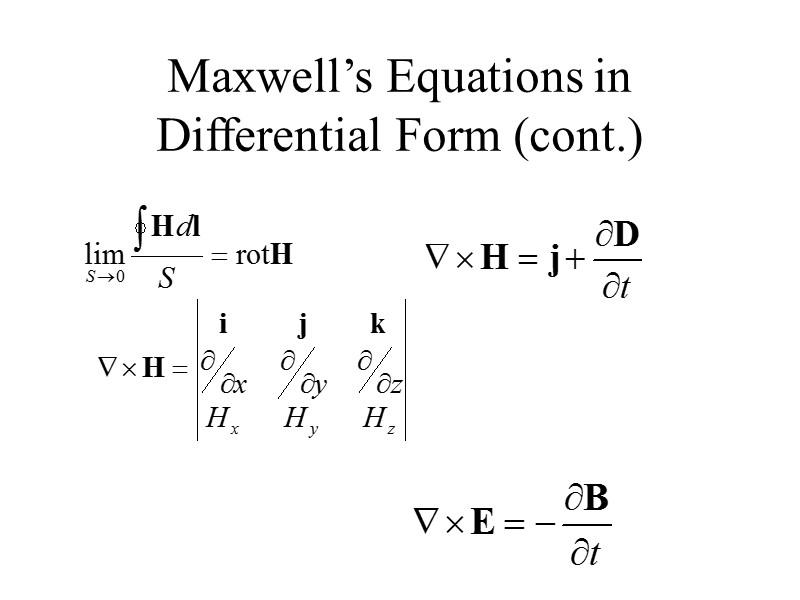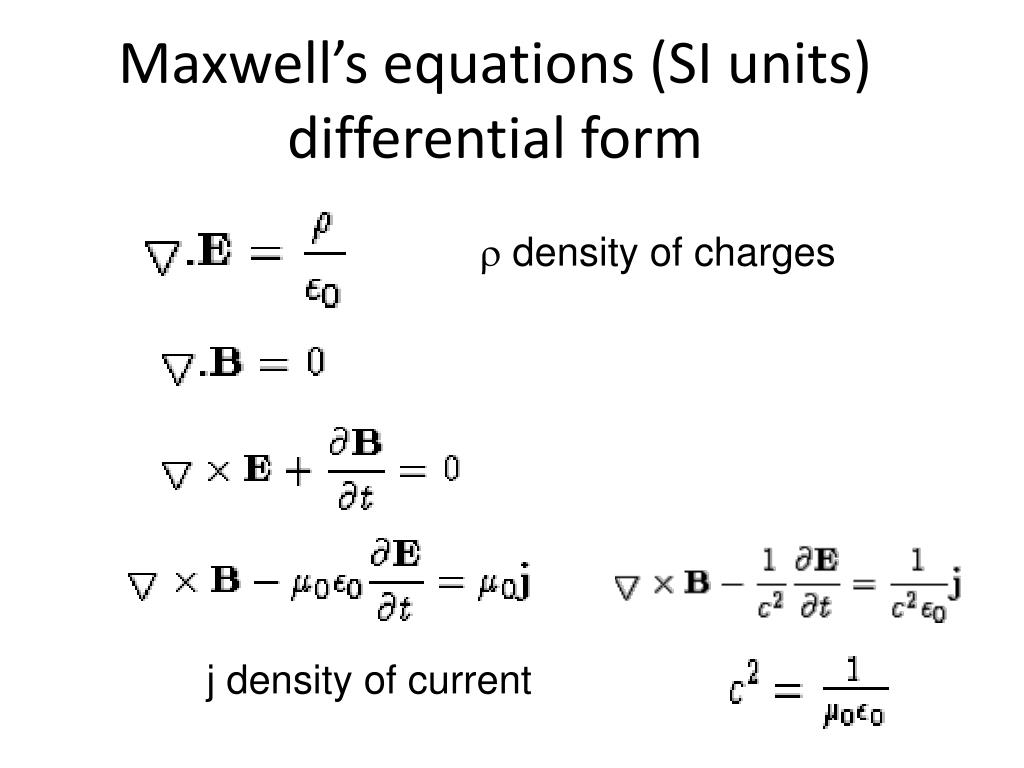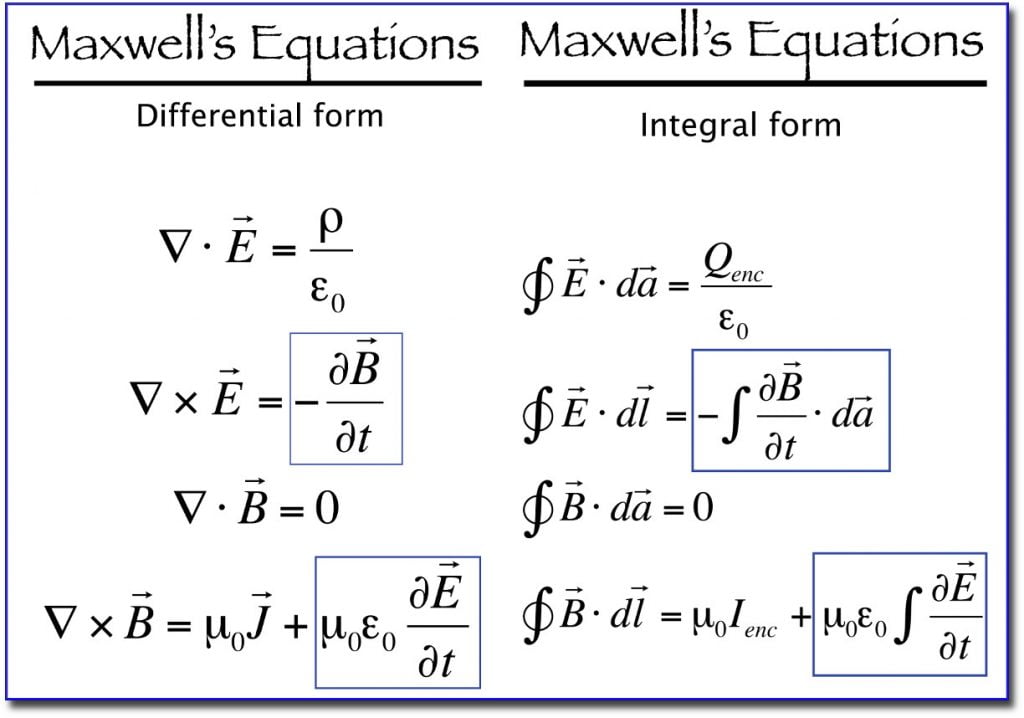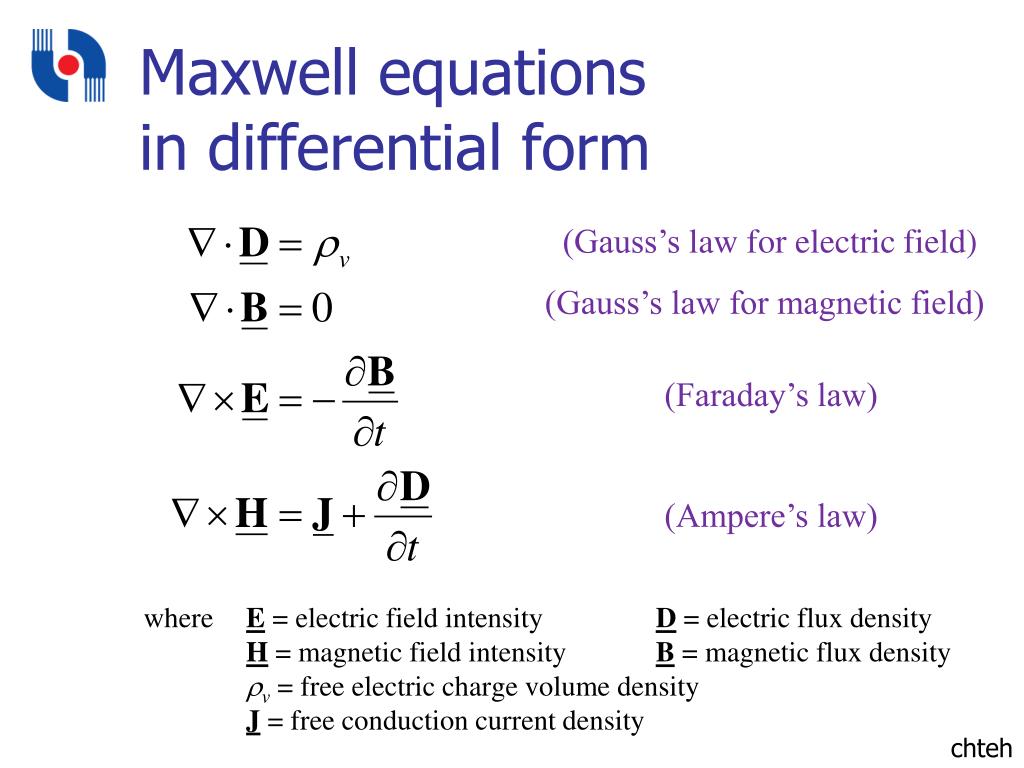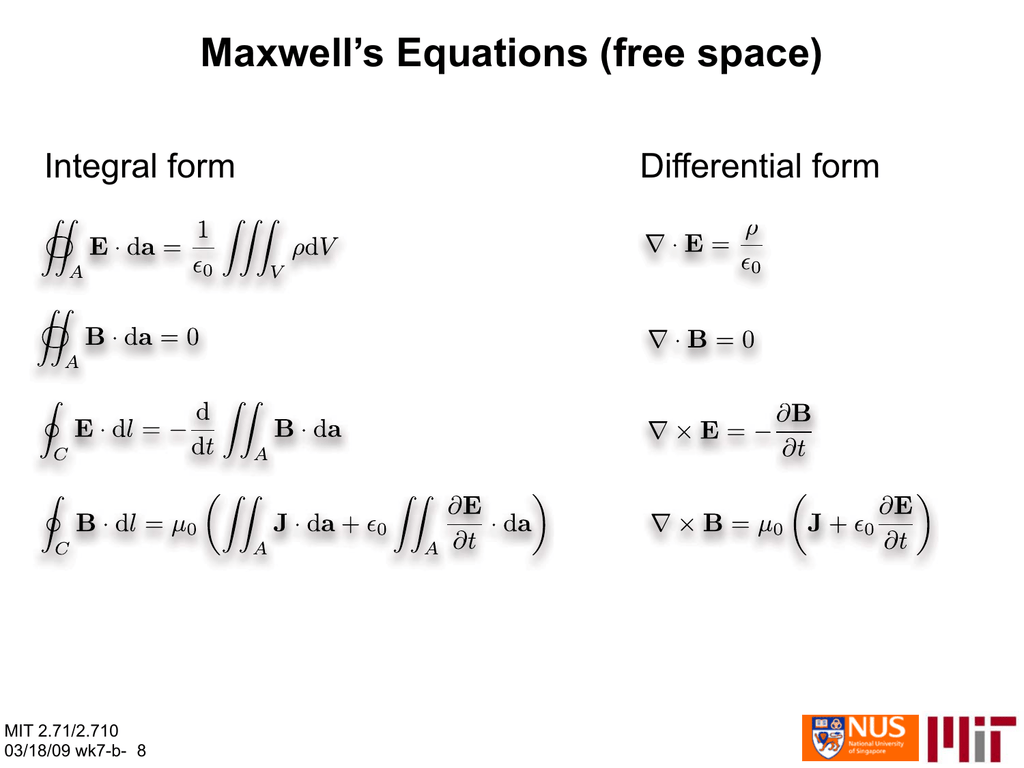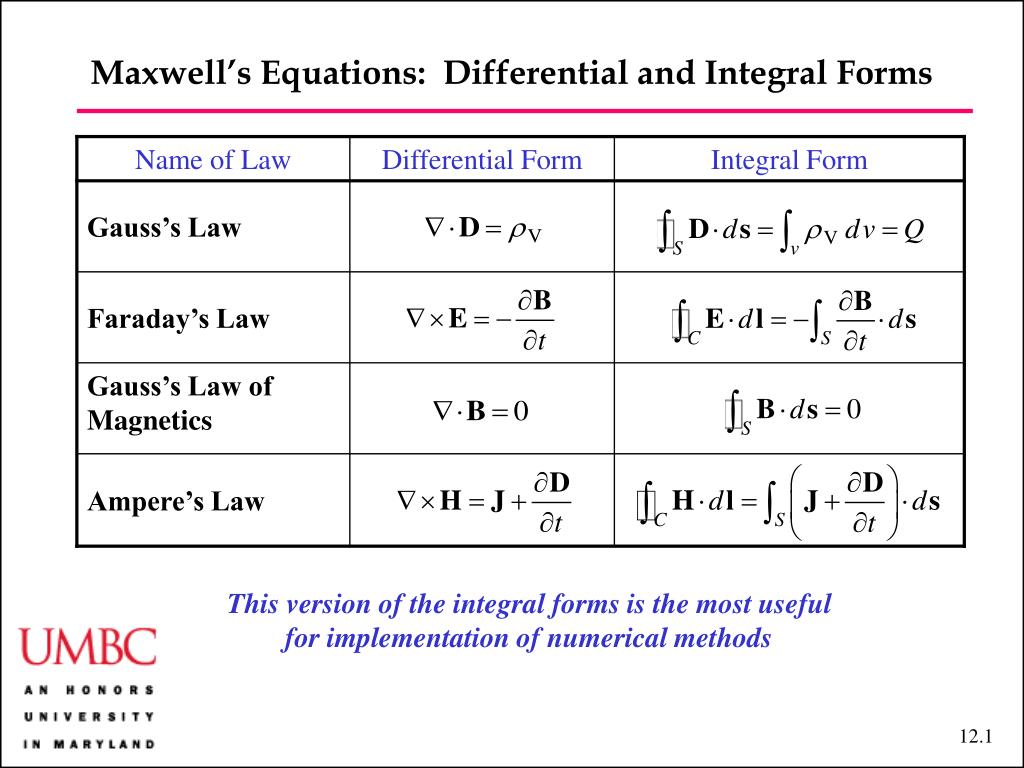Maxwell Equation In Differential Form
Maxwell Equation In Differential Form - So these are the differential forms of the maxwell’s equations. Maxwell's equations in their integral. (note that while knowledge of differential equations is helpful here, a conceptual understanding is possible even without it.) gauss’ law for electricity differential form: ∇ ⋅ e = ρ / ϵ0 ∇ ⋅ b = 0 ∇ × e = − ∂b ∂t ∇ × b = μ0j + 1 c2∂e ∂t. Web differential forms and their application tomaxwell's equations alex eastman abstract. Web maxwell’s equations in differential form ∇ × ∇ × ∂ b = − − m = − m − ∂ t mi = j + j + ∂ d = ji c + j + ∂ t jd ∇ ⋅ d = ρ ev ∇ ⋅ b = ρ mv ∂ = b , ∂ d ∂ jd t = ∂ t ≡ e electric field intensity [v/m] ≡ b magnetic flux density [weber/m2 = v s/m2 = tesla] ≡ m impressed (source) magnetic current density [v/m2] m ≡ Now, if we are to translate into differential forms we notice something: ∂ j = h ∇ × + d ∂ t ∂ = − ∇ × e b ∂ ρ = d ∇ ⋅ t b ∇ ⋅ = 0 few other fundamental relationships j = σe ∂ ρ ∇ ⋅ j = − ∂ t d = ε e b = μ h ohm' s law continuity equation constituti ve relationsh ips here ε = ε ε (permittiv ity) and μ 0 = μ Web what is the differential and integral equation form of maxwell's equations? Web the differential form of maxwell’s equations (equations 9.1.10, 9.1.17, 9.1.18, and 9.1.19) involve operations on the phasor representations of the physical quantities.
∇ ⋅ e = ρ / ϵ0 ∇ ⋅ b = 0 ∇ × e = − ∂b ∂t ∇ × b = μ0j + 1 c2∂e ∂t. The differential form uses the overlinetor del operator ∇: The del operator, defined in the last equation above, was seen earlier in the relationship between the electric field and the electrostatic potential. Web differentialform ∙ = or ∙ = 0 gauss’s law (4) × = + or × = 0 + 00 ampère’s law together with the lorentz force these equationsform the basic of the classic electromagnetism=(+v × ) ρ= electric charge density (as/m3) =0j= electric current density (a/m2)0=permittivity of free space lorentz force \bm {∇∙e} = \frac {ρ} {ε_0} integral form: Now, if we are to translate into differential forms we notice something: (note that while knowledge of differential equations is helpful here, a conceptual understanding is possible even without it.) gauss’ law for electricity differential form: ∫e.da =1/ε 0 ∫ρdv, where 10 is considered the constant of proportionality. The electric flux across a closed surface is proportional to the charge enclosed. ∂ j = h ∇ × + d ∂ t ∂ = − ∇ × e b ∂ ρ = d ∇ ⋅ t b ∇ ⋅ = 0 few other fundamental relationships j = σe ∂ ρ ∇ ⋅ j = − ∂ t d = ε e b = μ h ohm' s law continuity equation constituti ve relationsh ips here ε = ε ε (permittiv ity) and μ 0 = μ
Rs e = where : The alternate integral form is presented in section 2.4.3. There are no magnetic monopoles. Now, if we are to translate into differential forms we notice something: Maxwell 's equations written with usual vector calculus are. The del operator, defined in the last equation above, was seen earlier in the relationship between the electric field and the electrostatic potential. Web maxwell’s equations maxwell’s equations are as follows, in both the differential form and the integral form. The differential form of this equation by maxwell is. These equations have the advantage that differentiation with respect to time is replaced by multiplication by. Web differential forms and their application tomaxwell's equations alex eastman abstract.
Maxwells Equations Differential Form Poster Zazzle
In that case, the del operator acting on a scalar (the electrostatic potential), yielded a vector quantity (the electric field). Web maxwell’s equations maxwell’s equations are as follows, in both the differential form and the integral form. (2.4.12) ∇ × e ¯ = − ∂ b ¯ ∂ t applying stokes’ theorem (2.4.11) to the curved surface a bounded by.
Maxwell's 4th equation derivation YouTube
The alternate integral form is presented in section 2.4.3. (2.4.12) ∇ × e ¯ = − ∂ b ¯ ∂ t applying stokes’ theorem (2.4.11) to the curved surface a bounded by the contour c, we obtain: Now, if we are to translate into differential forms we notice something: In these expressions the greek letter rho, ρ, is charge density.
think one step more.. July 2011
Web maxwell’s first equation in integral form is. \bm {∇∙e} = \frac {ρ} {ε_0} integral form: These are the set of partial differential equations that form the foundation of classical electrodynamics, electric. In these expressions the greek letter rho, ρ, is charge density , j is current density, e is the electric field, and b is the magnetic field; Web.
maxwells_equations_differential_form_poster
∫e.da =1/ε 0 ∫ρdv, where 10 is considered the constant of proportionality. Web the simplest representation of maxwell’s equations is in differential form, which leads directly to waves; Web differential forms and their application tomaxwell's equations alex eastman abstract. (note that while knowledge of differential equations is helpful here, a conceptual understanding is possible even without it.) gauss’ law for.
Maxwell’s Equations Equivalent Currents Maxwell’s Equations in Integral
Web the classical maxwell equations on open sets u in x = s r are as follows: (2.4.12) ∇ × e ¯ = − ∂ b ¯ ∂ t applying stokes’ theorem (2.4.11) to the curved surface a bounded by the contour c, we obtain: So, the differential form of this equation derived by maxwell is. These equations have the.
PPT Maxwell’s equations PowerPoint Presentation, free download ID
From them one can develop most of the working relationships in the field. Maxwell was the first person to calculate the speed of propagation of electromagnetic waves, which was the same as the speed of light and came to the conclusion that em waves and visible light are similar. The electric flux across a closed surface is proportional to the.
Fragments of energy, not waves or particles, may be the fundamental
There are no magnetic monopoles. Maxwell's equations represent one of the most elegant and concise ways to state the fundamentals of electricity and magnetism. Maxwell’s second equation in its integral form is. Web answer (1 of 5): Web what is the differential and integral equation form of maxwell's equations?
PPT EMF2016 THEORY PowerPoint Presentation, free
Web we shall derive maxwell’s equations in differential form by applying maxwell’s equations in integral form to infinitesimal closed paths, surfaces, and volumes, in the limit that they shrink to points. The alternate integral form is presented in section 2.4.3. Maxwell’s second equation in its integral form is. These equations have the advantage that differentiation with respect to time is.
Maxwell’s Equations (free space) Integral form Differential form MIT 2.
The differential form of this equation by maxwell is. Web differential forms and their application tomaxwell's equations alex eastman abstract. Maxwell's equations represent one of the most elegant and concise ways to state the fundamentals of electricity and magnetism. There are no magnetic monopoles. Web maxwell’s equations in differential form ∇ × ∇ × ∂ b = − − m.
Web Maxwell’s Equations Maxwell’s Equations Are As Follows, In Both The Differential Form And The Integral Form.
Rs + @tb = 0; Web the classical maxwell equations on open sets u in x = s r are as follows: From them one can develop most of the working relationships in the field. Web maxwell’s first equation in integral form is.
So, The Differential Form Of This Equation Derived By Maxwell Is.
Web maxwell’s equations in differential form ∇ × ∇ × ∂ b = − − m = − m − ∂ t mi = j + j + ∂ d = ji c + j + ∂ t jd ∇ ⋅ d = ρ ev ∇ ⋅ b = ρ mv ∂ = b , ∂ d ∂ jd t = ∂ t ≡ e electric field intensity [v/m] ≡ b magnetic flux density [weber/m2 = v s/m2 = tesla] ≡ m impressed (source) magnetic current density [v/m2] m ≡ Electric charges produce an electric field. In these expressions the greek letter rho, ρ, is charge density , j is current density, e is the electric field, and b is the magnetic field; Its sign) by the lorentzian.
These Equations Have The Advantage That Differentiation With Respect To Time Is Replaced By Multiplication By Jω.
Differential form with magnetic and/or polarizable media: The alternate integral form is presented in section 2.4.3. ∂ j = h ∇ × + d ∂ t ∂ = − ∇ × e b ∂ ρ = d ∇ ⋅ t b ∇ ⋅ = 0 few other fundamental relationships j = σe ∂ ρ ∇ ⋅ j = − ∂ t d = ε e b = μ h ohm' s law continuity equation constituti ve relationsh ips here ε = ε ε (permittiv ity) and μ 0 = μ This paper begins with a brief review of the maxwell equationsin their \di erential form (not to be confused with the maxwell equationswritten using the language of di erential forms, which we will derive in thispaper).
Rs E = Where :
Web what is the differential and integral equation form of maxwell's equations? Web answer (1 of 5): There are no magnetic monopoles. The electric flux across a closed surface is proportional to the charge enclosed.




